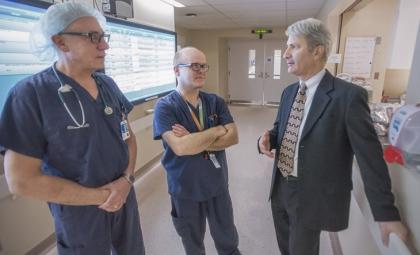In search of disruptive innovation

DR. MICHAEL APKON BELIEVES WE HAVE A UNIQUE OPPORTUNITY TO CREATE NEW MODELS OF CARE
Friday, March 02, 2018 – Ellen Gardner
Some days it might feel like we’re there, but The Hospital for Sick Children (SickKids) President and CEO Dr. Michael Apkon says we have some work to do before we see the kinds of patient-driven experiences that have disrupted many other industries.
At a Breakfast with the Chiefs talk in November, Apkon took a surprising and interesting leap into the past, giving delegates a quick lesson on the evolution of our healthcare system. We shouldn’t even try to predict where we’re going, he says, if we don’t appreciate how and why our system has evolved.
As he sees it, healthcare has developed through a series of stages – Healthcare 1.0 where we treated relatively simple episodes of care to Healthcare 2.0, treating very complex, but still few, episodes of care. The real changes started happening in the Healthcare 3.0 era – the era we’re in now in Canada – where care is a continuous service that addresses everything from prevention through disease management and rehabilitation in a coordinated way.
This might look like progress, but to Apkon, the pace of healthcare evolution is accelerating. “We have barely scratched the surface of the kinds of empowerment and engagement that other industries have achieved through digitization and other approaches,” he says. “That will be something completely different – a Healthcare 4.0.”
A NEED FOR DIFFERENT MODELS
Apkon traces the path to today – a time characterized by specialization and “a march towards greater value” – in a hopeful and somewhat nostalgic way. “With every evolution in healthcare, the importance of the prior pieces don’t go away. They very much remain but they are no longer sufficient in meeting people’s expectations,” he says.
As a physician, healthcare administrator and engineer, Apkon is trained to cast his gaze to other countries, other industries and other disciplines in the process of developing strategies for care delivery at SickKids. He sees his role and that of his leader colleagues as examining current models and looking for new ones – “That’s the engineer in me,” he says. If you want to have different outcomes, you need to build different models.
Along with his leadership team, Apkon has been dedicated to building on SickKids’ reputation as an iconic, field-shaping organization. “With the focus of our strategic plan, Building Connections and Accelerating Impact, it’s all about investing in two things - talent and integration.”
Predictably, not all of SickKids’ partnerships are within healthcare, a move Apkon says eases the friction between the larger system and local providers. “Technology is the great enabler,” he says. The Hospital is now working on an initiative with the SickKids Foundation called Technology for SickKids and is implementing a sophisticated electronic health record (EHR) for sharing patient data across the organization and with partners.
WHERE A MARKET OPPORTUNITY EXISTS, SOMEONE WILL GO AFTER IT
Before coming to Canada, Apkon was Chief Medical Officer for the Children’s Hospital of Philadelphia (CHOP) and prior to that held several senior executive roles at Yale New Haven Health System. He continues to be impressed with the pace of change south of the border. “In the U.S. I’ve found they embrace a philosophy of disruptive innovation because organizations know that where a market opportunity exists, someone is going to go after it. That means if you aren’t part of the disruption, your own business may be disrupted by someone else.”
The challenge of unlocking data and overcoming regulatory restrictions has been a problem in several U.S. jurisdictions. Using a disruptive approach, their solution was to come together in clinically integrated systems that collaborate to care for large populations and deliver a wide range of services.
Apkon would love to see a similar evolution in Canada’s approach to reshaping healthcare. “We have a unique opportunity in Ontario to create new models of care,” he says. “Unlike other provinces that have more centralized systems, our organizations are fairly autonomous and that creates greater freedom to innovate as well as more sparks for innovation. We should be taking advantage of that freedom.”
That philosophy is guiding the way some of the most powerful healthcare systems in the U.S. are reaching down into local systems. Apkon admits he was skeptical when he saw Cincinnati Children’s Hospital creating a plan for tackling paediatric health issues in the city’s socioeconomically challenged areas using a population health approach – leveraging school clinics, fire departments, and many other community agencies. “I wondered, how could they have an impact?”
But the results have been impressive – particularly with children suffering from asthma. “The quality of their work in addressing the social determinants of care is very high,” he says. “It shows what can happen if an organization takes on a broader mandate.”
The evolutionary path we are on in healthcare is inevitable, says Apkon. “If we don’t go there, someone else will innovate around you. People will simply not settle for less in healthcare than they expect in other industries.”
By Ellen Gardner, Senior Specialist, Communications and Marketing, HIROC